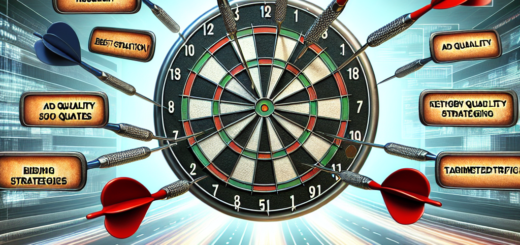Building a strong digital brand
Are you looking to build a strong digital brand? In today’s digital landscape, it’s essential to establish a strong online presence to stand out from the competition. This means optimizing your website with on-page and off-page SEO strategies, utilizing search engine marketing platforms like Google Ads and Bing Ads, and leveraging the power of social media marketing on platforms like Facebook, Instagram, Twitter, and LinkedIn. Content marketing is also key, with a focus on developing a comprehensive blog content strategy, creating engaging video content, and promoting infographics. Additionally, email marketing, digital analytics, e-commerce marketing, and influencer collaborations all play a crucial role in building your digital brand. Stay tuned to learn more about effective strategies and tools to help make your brand thrive in the digital world.
Search Engine Optimization (SEO)
Search Engine Optimization (SEO) is a crucial aspect of any digital marketing strategy. It involves optimizing your website and its content to improve its visibility on search engine results pages (SERPs). There are several components to SEO that can help drive organic traffic to your website.

On-page SEO
On-page SEO refers to optimizing individual web pages to improve their search engine rankings. This includes using relevant keywords in the page title, meta tags, headings, and content. It also involves optimizing images, adding internal links, and improving the overall user experience on the page.
Off-page SEO
Off-page SEO involves optimizing factors outside of your website that can impact its search engine rankings. This includes building high-quality backlinks from reputable websites, social media shares, and online mentions. Off-page SEO can help increase your website’s credibility and authority in the eyes of search engines.
SEO tools
There are various SEO tools available that can help you with keyword research, competition analysis, website audits, and tracking your search engine rankings. Some popular SEO tools include SEMrush, Moz, Ahrefs, and Google Search Console. These tools provide valuable insights and data to enhance your SEO efforts.
Local SEO
Local SEO focuses on optimizing your website to rank higher in local search results. It is particularly important for businesses that operate in specific geographical areas. Local SEO involves optimizing your website’s content with location-specific keywords, creating and optimizing a Google My Business listing, and obtaining positive reviews from local customers.
Search Engine Marketing (SEM)
Search Engine Marketing (SEM) is another essential aspect of digital marketing. It involves promoting your website through paid advertisements on search engines like Google and Bing. SEM can help drive targeted traffic to your website and increase conversions.
Google Ads
Google Ads is the most popular SEM platform, allowing advertisers to create and manage pay-per-click (PPC) campaigns. With Google Ads, you can display ads on Google’s search results pages, partner websites, and YouTube. It offers various targeting options and allows you to track and optimize your campaigns for maximum results.
Bing Ads
Bing Ads is Microsoft’s advertising platform, serving ads on Bing and Yahoo search engines. It provides similar targeting options to Google Ads and can be a valuable addition to your SEM strategy, especially if you’re targeting a specific audience that uses Bing as their primary search engine.
Paid search advertising
Paid search advertising involves bidding for ad placements on search engine results pages. It allows you to display targeted ads to users who are actively searching for products or services related to your business. Paid search ads appear at the top or bottom of search engine results and can significantly increase your website’s visibility and click-through rates.
Ad campaign management
Managing ad campaigns effectively is crucial for achieving optimal results. It involves setting campaign goals, selecting the right keywords, creating compelling ad copy, and regularly monitoring and optimizing campaigns based on performance data. Ad campaign management requires strategic planning and continuous testing to improve conversion rates and return on investment.
Social Media Marketing
Social Media Marketing is a powerful tool for businesses to engage with their target audience and build brand awareness. With billions of users worldwide, platforms like Facebook, Instagram, Twitter, and LinkedIn offer various opportunities for businesses to connect with their customers.
Facebook marketing
Facebook is the largest social media platform globally, making it an essential platform for businesses of all sizes. Facebook marketing involves creating and managing business pages, running targeted ad campaigns, engaging with followers, and using powerful analytics to measure performance.
Instagram advertising
Instagram is a visually-oriented platform that allows businesses to display their products or services creatively. Instagram advertising involves running photo and video ads, utilizing Instagram Stories, and collaborating with influencers to reach a broader audience. It’s an effective platform for businesses in industries like fashion, beauty, food, and travel.
Twitter promotion
Twitter is a real-time platform that enables businesses to share updates, news, and engage with their audience through short and concise messages called tweets. Twitter promotion involves posting engaging content, leveraging hashtags, running promoted tweets, and actively participating in conversations to increase brand visibility and drive traffic to your website.
LinkedIn marketing strategy
LinkedIn is a professional networking platform that caters to a more business-oriented audience. It offers a range of marketing opportunities for businesses, including creating a company page, publishing thought leadership content, running targeted ads, and utilizing LinkedIn groups for networking and engagement. LinkedIn is particularly effective for B2B marketing and recruitment efforts.
Content Marketing
Content Marketing involves creating and distributing valuable and relevant content to attract and engage a specific target audience. It is an effective strategy to build brand awareness, establish authority, and drive organic traffic to your website.
Blog content strategy
Blogging is a popular form of content marketing that allows businesses to showcase their expertise and provide valuable information to their audience. A blog content strategy involves identifying target keywords, creating a content calendar, producing high-quality blog posts, and promoting them through various channels.
Content creation tools
There are numerous content creation tools available that can streamline the content creation process and enhance the quality of your content. These tools include grammar and plagiarism checkers, keyword research tools, content ideation platforms, and content management systems. By leveraging these tools, you can produce engaging and well-optimized content more efficiently.
Video content marketing
Video content is becoming increasingly popular and can be a powerful tool for engaging your target audience. Video content marketing involves creating informative and engaging videos that provide value to your audience. These videos can be shared on platforms like YouTube, social media, or embedded on your website for maximum exposure.
Infographic promotion
Infographics are visual representations of data or information that make complex concepts easier to understand. Infographic promotion involves creating visually appealing and informative infographics and sharing them on various platforms, such as social media, websites, and blogs. Infographics can help increase brand visibility, attract backlinks, and generate social media shares.
Email Marketing
Email Marketing is a highly effective strategy for nurturing leads, building relationships with customers, and driving conversions. It allows businesses to communicate directly with their audience and deliver personalized and targeted messages.
Email automation
Email automation involves setting up automated email campaigns triggered by specific actions or events. This can include welcome emails, abandoned cart reminders, personalized recommendations, and post-purchase follow-ups. Email automation saves time and enables businesses to deliver timely and relevant content to their subscribers.
Email campaign optimization
Optimizing email campaigns involves testing different components such as subject lines, email content, call-to-action buttons, and sending times to maximize open rates, click-through rates, and conversions. A/B testing and analyzing campaign metrics can help identify areas for improvement and optimize email campaigns for better performance.

Email marketing tools
There are numerous email marketing tools available that can streamline the email marketing process and provide valuable insights. These tools offer features such as email list management, email templates, automation workflows, segmentation, and analytics. Popular email marketing tools include Mailchimp, Constant Contact, and HubSpot.
Newsletter best practices
Newsletters are a common form of email marketing that businesses use to keep subscribers informed about their latest news, offers, and industry insights. Newsletter best practices involve creating engaging and valuable content, segmenting your email list, personalizing the emails, optimizing for mobile devices, and regularly analyzing the performance of your newsletters.
Digital Analytics
Digital Analytics involves collecting, analyzing, and interpreting data from various digital marketing channels to measure performance, gain insights, and make data-driven decisions. It plays a crucial role in understanding the effectiveness of your marketing efforts and identifying areas for improvement.
Google Analytics tips
Google Analytics is a powerful tool used by businesses to track and measure website traffic, user behavior, conversions, and more. Tips for utilizing Google Analytics effectively include setting up goals, creating custom reports, utilizing UTM codes for campaign tracking, analyzing bounce rates, and using event tracking to measure specific interactions on your website.
Data-driven marketing
Data-driven marketing involves using data and analytics to determine strategies, optimize campaigns, and make informed marketing decisions. It involves collecting and analyzing data from various sources, identifying patterns, and using these insights to create more targeted and personalized marketing campaigns.
Web analytics tools
In addition to Google Analytics, there are several web analytics tools available that can provide valuable insights into your website’s performance. These tools offer features such as heat mapping, user session recordings, conversion funnels, and real-time analytics. Popular web analytics tools include Hotjar, Crazy Egg, and Kissmetrics.
Analytics reporting
Analytics reporting involves analyzing and presenting data in a meaningful and actionable format. Effective reporting includes creating custom dashboards, visualizing data through charts and graphs, highlighting key metrics, and providing insights and recommendations based on the data. Regular reporting helps track progress and measure the success of your digital marketing efforts.
E-commerce Marketing
E-commerce Marketing involves promoting and selling products or services online. With the rise of online shopping, businesses need to implement effective marketing strategies to attract customers and drive sales.
Online store optimization
Optimizing your online store involves creating user-friendly and visually appealing product pages, streamlining the checkout process, optimizing product descriptions with relevant keywords, and utilizing customer reviews. By optimizing your online store, you can enhance the user experience, increase conversion rates, and improve search engine rankings.
E-commerce SEO
E-commerce SEO involves optimizing your online store’s content and structure to improve its visibility in search engine results. This includes conducting keyword research, optimizing product titles and descriptions, creating valuable content, improving site speed, and implementing structured data markup. E-commerce SEO can help drive organic traffic and increase sales.
Product listing ads
Product listing ads (PLAs) are visual ads that appear on search engine results pages when users search for specific products. PLAs include product images, titles, prices, and other relevant information. Running product listing ads can increase the visibility of your products and attract qualified traffic to your online store.
Cart abandonment strategies
Cart abandonment is a common challenge for e-commerce businesses. Implementing cart abandonment strategies, such as sending personalized email reminders, offering incentives, and streamlining the checkout process, can help reduce cart abandonment rates and increase conversions. It’s essential to understand the reasons behind cart abandonment and address them effectively.
Influencer Marketing
Influencer Marketing involves partnering with influential individuals on social media platforms to promote your products or services. Leveraging the reach and credibility of influencers can help increase brand awareness, reach new audiences, and drive sales.
Influencer collaborations
Collaborating with influencers involves identifying influencers in your niche, reaching out to them, and developing mutually beneficial partnerships. Influencer collaborations can take the form of sponsored posts, product reviews, giveaways, or brand ambassadorships. It’s crucial to find influencers whose values align with your brand and make sure their audience matches your target market.
Influencer outreach
Effective influencer outreach involves building relationships with influencers through personalized messages, providing value to them, and offering compelling partnership opportunities. Building genuine connections with influencers can lead to long-term partnerships and increase the success of your influencer marketing campaigns.
Micro-influencers
Micro-influencers are individuals with a smaller but highly engaged following on social media. Collaborating with micro-influencers can be beneficial, as their audience tends to be more niche-specific and highly receptive to their recommendations. Micro-influencers often have higher engagement rates and can provide more targeted exposure for your brand.
Influencer marketing platforms
Influencer marketing platforms act as intermediaries between influencers and brands, making it easier to find, connect, and collaborate with influencers. These platforms provide tools for influencer discovery, campaign management, contract negotiations, and performance tracking. Some popular influencer marketing platforms include AspireIQ, Upfluence, and Famebit.
Digital Branding
Digital branding involves creating a cohesive and consistent brand image across various digital channels. It encompasses the visual elements of your brand, such as your logo and website design, as well as the tone of voice and messaging used in your content.
Building a strong digital brand requires careful crafting and implementation of your brand identity:
- Define your brand’s values, personality, and positioning in the market.
- Design a visually appealing and memorable brand identity, including your logo, color scheme, and typography.
- Develop a cohesive brand voice that reflects your brand’s personality and resonates with your target audience.
- Consistently apply your brand identity across all digital channels, including your website, social media profiles, email newsletters, and other marketing materials.
- Monitor your brand’s online reputation and actively engage with your audience to build trust and loyalty.
- Utilize storytelling techniques to create a compelling brand narrative that establishes an emotional connection with your audience.
- Continuously evaluate and adapt your branding strategy based on market trends, customer feedback, and business goals.
By investing time and effort into digital branding, you can differentiate your brand from competitors, foster brand loyalty, and create a memorable and impactful online presence.
In conclusion, a comprehensive digital marketing strategy incorporates various tactics and channels to reach and engage target audiences. From SEO and SEM to social media marketing and content marketing, each aspect plays a crucial role in driving website traffic, increasing brand visibility, and converting leads into customers. By leveraging the power of email marketing, digital analytics, e-commerce marketing, influencer marketing, and effective branding, businesses can achieve their marketing objectives and thrive in the digital landscape.
















It's great that you talked about how business insurance can provide financial protection against unexpected events and help ensure the…
I like that you mentioned how business insurance is essential for protecting your bottom line and the long-term viability of…